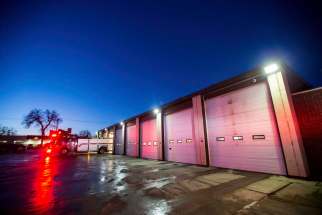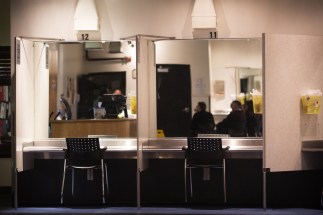Safe schools? Parents want proof Inadequate information on province's COVID dashboard 'undermines confidence,' mother says
Read this article for free:
or
Already have an account? Log in here »
To continue reading, please subscribe:
Monthly Digital Subscription
$0 for the first 4 weeks*
- Enjoy unlimited reading on winnipegfreepress.com
- Read the E-Edition, our digital replica newspaper
- Access News Break, our award-winning app
- Play interactive puzzles
*No charge for 4 weeks then price increases to the regular rate of $19.00 plus GST every four weeks. Offer available to new and qualified returning subscribers only. Cancel any time.
Monthly Digital Subscription
$4.75/week*
- Enjoy unlimited reading on winnipegfreepress.com
- Read the E-Edition, our digital replica newspaper
- Access News Break, our award-winning app
- Play interactive puzzles
*Billed as $19 plus GST every four weeks. Cancel any time.
To continue reading, please subscribe:
Add Free Press access to your Brandon Sun subscription for only an additional
$1 for the first 4 weeks*
*Your next subscription payment will increase by $1.00 and you will be charged $16.99 plus GST for four weeks. After four weeks, your payment will increase to $23.99 plus GST every four weeks.
Read unlimited articles for free today:
or
Already have an account? Log in here »
Hey there, time traveller!
This article was published 24/02/2021 (1751 days ago), so information in it may no longer be current.
Despite various changes in how the province releases information about COVID-19 cases in schools, parents still aren’t satisfied with the data being made public.
Halfway through the academic year, families behind a new letter-writing campaign are calling for more detail about cases in both school and child-care settings, citing heightened concerns about the risk of new coronavirus variants.
The group wants daily updates on exposures that include facility names, dates and total cases broken down into student and staff categories, historical data so the public can track trends, and information about variants identified.
“In terms of what they’re publicly reporting on, it’s very, very limited. I think it undermines confidence in the statement that schools are safe and they aren’t seeing transmission,” said Susan Wingert, a mother of two K-12 students in Winnipeg.

Wingert said reporting via an online dashboard, which launched earlier this month, falls short of providing all the information parents need to weigh decisions about sending children to school.
The provincial dashboard shows cases among both student and staff populations within the last 14 days, as well as totals dating back to Sept. 1.
A map allows users to view recent cases in specific schools, including people who might not have been infectious in a classroom; there is no information on which — if any — cases were acquired at school.
It’s a stark contrast to the first-ever alert, which detailed the grade, classroom and time frame at Churchill High School for a student who was asymptomatic but tested positive Sept. 8.
Following pushback after that notice, the province began to publish a running list of less-specific notices, including exposure dates and letters sent to families until mid-December. That’s when letters disappeared online for more than a month while the province finalized its dashboard.
Child-care centres are not included in the provided information.
The most recent data shows there were 75 cases, involving 59 students and 16 staff members, during the incubation period prior to Feb. 21.
Michelle Driedger, who researches health-risk communication at the University of Manitoba, questions the usefulness of that information if it isn’t contextualized.
“There has to be a happy medium between full disclosure of absolutely everything and, ‘Here, we’re giving you some information, but in such an opaque environment that you can almost interpret what you want from it,’” said Driedger, a professor of community health sciences and parent of two K-12 students.
Buy-in to COVID-19 protocols requires confidence in the system, she said, adding the province should be frank about how exactly it has come to the conclusion schools are safe.

Education Minister Cliff Cullen was not made available for an interview Wednesday. In an email statement, he wrote the province is confident parents are receiving the “appropriate information” on the dashboard while noting letters are still being sent to parents when there is an outbreak.
School-related cases represent approximately seven per cent of the number of confirmed cases in Manitoba, to date.
School case counts have paralleled COVID-19 trends in the community, said epidemiologist Cynthia Carr, adding it’s understandable parents are anxious about their children’s well-being — especially now that the highly contagious B.1.1.7 strain that originated in the United Kingdom has been identified in five Manitoba cases.
The founder of EPI Research Inc. has long been an advocate for pool testing in schools to identify the prevalence of asymptomatic spread. As researchers learn more about the new variant, it may be worth investing in both pooled testing and genomics sequencing in positive cases to see if the variant is becoming predominant among young people and patterns are changing, Carr said.
She noted Montreal reported 22 variant outbreaks, which are almost entirely in schools and daycare settings, on Wednesday.
On the subject of asymptomatic testing, Cullen said in the email the province is seeing its COVID-19 curve bend significantly.
“Our government will continue to listen to our public health leaders and take action accordingly,” he wrote.
maggie.macintosh@freepress.mb.ca
Twitter: @macintoshmaggie

Maggie Macintosh reports on education for the Winnipeg Free Press. Funding for the Free Press education reporter comes from the Government of Canada through the Local Journalism Initiative.
Our newsroom depends on a growing audience of readers to power our journalism. If you are not a paid reader, please consider becoming a subscriber.
Our newsroom depends on its audience of readers to power our journalism. Thank you for your support.









